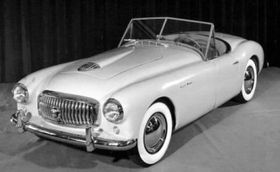Nash-Healey
| Nash-Healey | |
|---|---|

1951 Nash-Healey
|
|
| Overview | |
| Manufacturer | Nash Motors |
| Production | 1951–1954 |
| Assembly | |
| Body and chassis | |
| Class | Sports car |
| Body style | |
| Layout | Front-engine, rear-wheel-drive |
| Powertrain | |
| Engine |
|
| Transmission | 3-speed manual with overdrive |
| Dimensions | |
| Wheelbase |
|
| Length |
|
| Width |
|
| Height |
|
| Curb weight | 2,400 lb (1,089 kg) ~ approximate |
The Nash-Healey is a two-seat sports car that was produced for the American market between 1951 and 1954. Marketed by Nash-Kelvinator Corporation with the Nash Ambassador drivetrain and a European chassis and body, it served as a halo (or image) vehicle, or flagship car, for the automaker to promote the sales of the other Nash models. It was "America's first post-war sports car", and the first introduced in the U.S. by a major automaker since the Great Depression. The Nash-Healey was the product of the partnership between Nash-Kelvinator Corporation and British automaker Donald Healey. Later on, the car was restyled by Pinin Farina and subassembly began in Italy.
A racing version, built with a spartan aluminum body, finished third in the 1952 Le Mans 24-hour race.
Donald Healey and Nash-Kelvinator CEO George W. Mason met on the Queen Elizabeth, an ocean liner going from the United States to Great Britain. Healey was returning to England after his attempt to purchase engines from Cadillac, but General Motors declined his idea. His idea was to expand production of the Healey Silverstone that race car driver Briggs Cunningham had customized with Cadillac’s new 1949 overhead-valve V8 engine. Mason and Healey met over dinner and a production plan ensued during the remainder of the voyage. The two became friends because they were both interested in photography. Mason had a stereo (3-D) camera that intrigued Healey.
...
Wikipedia
